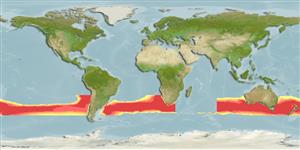Common names from other countries
>
Zeiformes (Dories) >
Oreosomatidae (Oreos) > Oreosomatinae
Etymology: Neocyttus: Greek, neos = new + Greek, kyttaros, kytos = a convex cavity.
Environment: milieu / climate zone / depth range / distribution range
Ecologia
marino batipelagico; oceanodromo (Ref. 51243); distribuzione batimetrica 200 - 1240 m (Ref. 6390), usually 450 - 800 m (Ref. 30191). Deep-water; 23°S - 48°S, 81°W - 176°W
Southeast Atlantic: off Walvis Bay, Namibia to Cape Province, South Africa. Southwest Atlantic: off Argentina. Eastern Indian Ocean: southern Australia, from about 26°S in Western Australia to Broken Bay (Ref. 7300), New South Wales. Southwest Pacific: New Zealand.
Length at first maturity / Size / Peso / Age
Maturity: Lm 34.0, range 29 - ? cm
Max length : 40.0 cm SL maschio/sesso non determinato; (Ref. 30191); peso massimo pubblicato: 2.0 kg (Ref. 6390); Età massima riportata: 100 anni (Ref. 27140)
Spine dorsali (totale) : 7; Raggi dorsali molli (totale) : 33 - 35; Spine anali: 3 - 4; Raggi anali molli: 30 - 33. Body grey, fins dark (Ref. 6548).
Inhabit continental slopes (Ref. 9563), forming large shoals over rough ground near pinnacles and canyons (Ref. 6390). Juveniles are pelagic and tend to be dispersed over smooth grounds (Ref. 6390). Feed on salps, fish, crustaceans and squid (Ref. 27230). Eggs float near the surface and larvae also inhabit surface waters (Ref. 6390).
Life cycle and mating behavior
Maturities | Riproduzione | Spawnings | Egg(s) | Fecundities | Larve
Displays seasonally synchronised reproduction.
Karrer, C., 1990. Oreosomatidae. p. 637-640. In J.C. Quero, J.C. Hureau, C. Karrer, A. Post and L. Saldanha (eds.) Check-list of the fishes of the eastern tropical Atlantic (CLOFETA). JNICT, Lisbon; SEI, Paris; and UNESCO, Paris. Vol. 2. (Ref. 6545)
IUCN Red List Status (Ref. 130435)
CITES (Ref. 128078)
Not Evaluated
Threat to humans
Harmless
Human uses
Pesca: scarso interesse commerciale
Strumenti
Special reports
Download XML
Fonti Internet
Estimates based on models
Preferred temperature (Ref.
115969): 5 - 9.7, mean 7.8 (based on 131 cells).
Phylogenetic diversity index (Ref.
82804): PD
50 = 0.5635 [Uniqueness, from 0.5 = low to 2.0 = high].
Bayesian length-weight: a=0.01698 (0.00988 - 0.02919), b=3.01 (2.85 - 3.17), in cm Total Length, based on LWR estimates for this species & (Sub)family-body (Ref.
93245).
Trophic level (Ref.
69278): 3.6 ±0.53 se; based on food items.
Resilienza (Ref.
120179): Molto basso, tempo minimo di raddoppiamento della popolazione più di 14 anni (tmax=100).
Fishing Vulnerability (Ref.
59153): High to very high vulnerability (70 of 100).
Climate Vulnerability (Ref.
125649): Moderate vulnerability (41 of 100).
